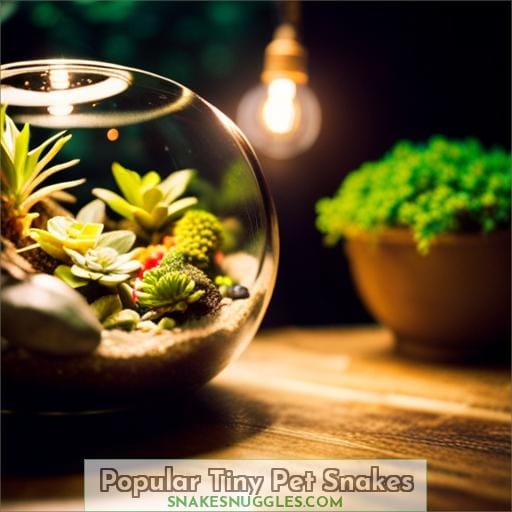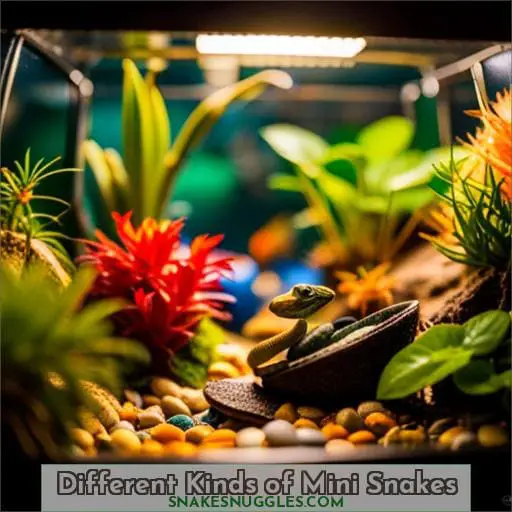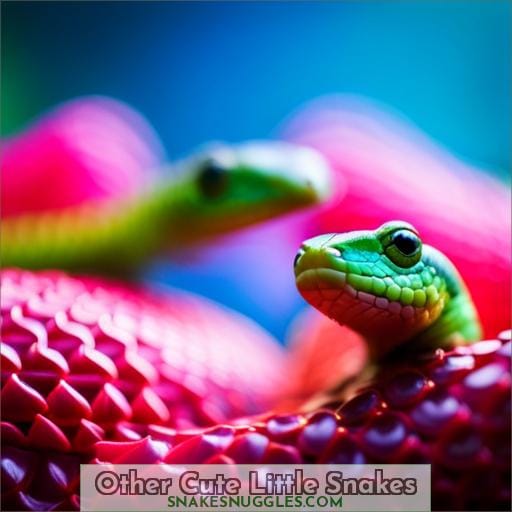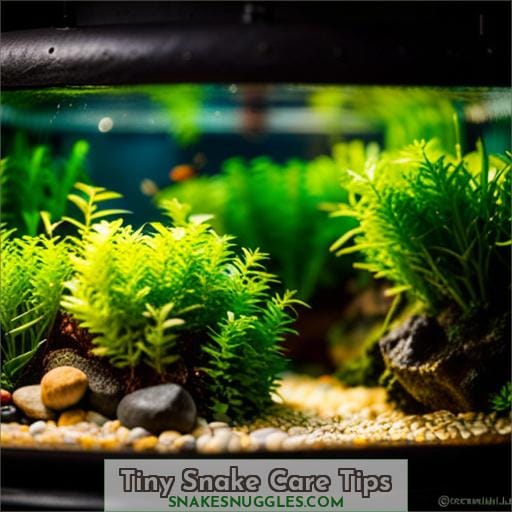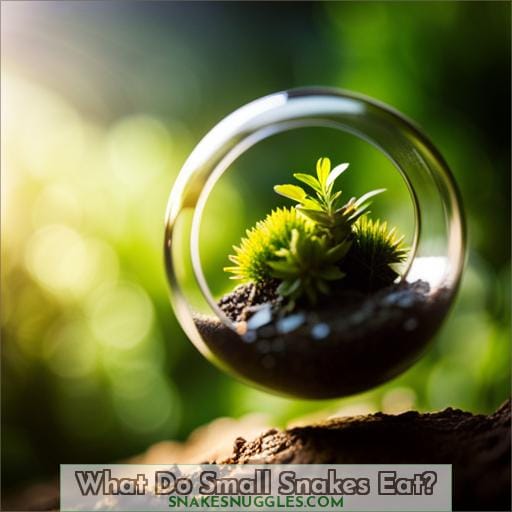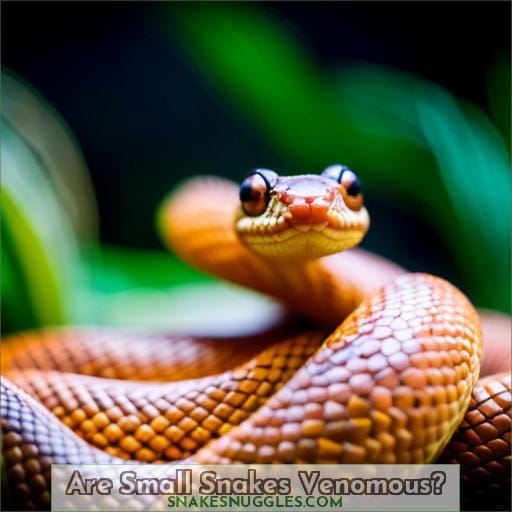This site is supported by our readers. We may earn a commission, at no cost to you, if you purchase through links.
 Imagine a world where you can cuddle with a snake, not just any snake, but the tiniest, cutest ones that will fit perfectly in the palm of your hand.
Imagine a world where you can cuddle with a snake, not just any snake, but the tiniest, cutest ones that will fit perfectly in the palm of your hand.
These miniature serpents, known as the smallest pet snakes, are gaining popularity as exotic pets due to their manageable size, gentle nature, and captivating appearance.
From the vibrant hues of rosy boas to the sleek patterns of milk snakes, these pocket-sized wonders offer an intriguing and rewarding pet-owning experience.
Dive into the world of these captivating creatures and discover the charm and beauty of the tiniest pet snakes that will steal your heart.
Table Of Contents
- Key Takeaways
- Good Starter Snakes
- Popular Tiny Pet Snakes
- Advantages of Small Snakes
- Different Kinds of Mini Snakes
- Other Cute Little Snakes
- Tiny Snake Care Tips
- What Do Small Snakes Eat?
- Are Small Snakes Venomous?
- Lifespan of Tiny Snakes
- Avoiding Escape Artists
- Frequently Asked Questions (FAQs)
- What is the absolute smallest snake breed that can be kept as a pet?
- Are any of these cute little snakes suitable for children to handle?
- How often do I need to clean the enclosure for a small snake?
- What’s the best way to pick up and handle a small snake without scaring it?
- What signs should I look out for if my small snake stops eating regularly?
- Conclusion
Key Takeaways
- Rosy boas are small, docile snakes with beautiful color variations that make great beginner pets.
- Smooth green snakes have vibrant green scales and slender bodies, adding to their visual appeal as tiny pet snakes.
- Milk snakes grow under 3 feet long, have red saddle-like bands, and are nonvenomous mimics of the venomous coral snake.
- Thread snakes are the smallest snakes in the world and have unique adaptations for their tiny size, though they require tropical climates.
Good Starter Snakes
Several good starter snakes for beginners are docile species that stay under 3 feet long as adults, such as rosy boas, corn snakes, and ball pythons.
When selecting your first pet snake, consider size constraints both as babies and full-grown adults. Most starter breeds max out around 3-4 feet, which is manageable for a new herpetology hobbyist.
Docile temperaments characterized by a reluctance to bite make species like the rosy boa and corn snake ideal for initial handling experience. Their small size also means you can house them comfortably in a 20-30 gallon tank.
As far as care requirements, these starter snakes have simple needs when it comes to temperature regulation, humidity, and feeding.
Overall, smooth green snakes, rosy boas, and milk snakes are all good options for beginner pet snake owners looking to start small.
Popular Tiny Pet Snakes
When looking for a tiny pet snake to cuddle, consider rosy boas, hognose snakes, and ball pythons.
These small, docile breeds make for sweet, manageable pets that stay under 3 feet long.
Let’s take a closer look at some key traits of these pint-sized serpents:
Rosy Boas
You’ll love rosy boas for their small size, docile temperament, and beautiful color variations that make them one of the most popular tiny pet snakes.
Rosy boas come in a variety of pink, orange, brown, and yellow hues with distinctive dorsal stripes.
Though small, rosy boas require a secure habitat with hides, substrate, and a thermal gradient to thrive.
When handled gently, these mild-mannered snakes rarely bite.
Hognose Snakes
Another popular tiny pet snake you’ll want to consider is the hognose snake, known for its blunt, upturned snout, wide head, and large eyes.
They use their snouts for digging in the sandy soils they inhabit.
They vary in size, and many can be easily handled since they don’t exceed more than a foot or two long.
These docile, unique snakes with interesting behaviors are common pets due to being easy to care for.
Ball Pythons
Continuing from hognose snakes, you’re finding ball pythons being another popular tiny pet snake native to Africa.
Though threatened by hunting and pet trade, they remain a docile captive bred choice reaching just 2-5 feet long.
- Color morphs with various patterns and colors
- Require proper heat and humidity
- Prone to respiratory infections if conditions are poor
Advantages of Small Snakes
When choosing a pet snake, smaller breeds have distinct advantages.
Their tiny size makes them easy to handle and transport, while their modest appetites keep feeding costs low.
Selecting a petite serpent like a smooth green or Kenyan sand boa can therefore be ideal for first-time or budget-conscious owners.
Easy Handling
You can easily handle these tiny snakes without worrying about getting injured or straining your muscles.
Their small size makes them easy to interact with using proper handling techniques like scooping underneath or letting them slither through your hands.
You can do fun bonding exercises like setting up enrichment in their small snake enclosures.
Monitoring their health is much simpler too since you can thoroughly inspect their tiny bodies.
Here’s a quick reference for handling tiny snakes:
| Task | Method | Tips |
|---|---|---|
| Picking Up | Scoop underneath towards head | Avoid tail |
| Holding | Support body, don’t squeeze | Let relax on hand |
| Setting Down | Lower a few inches above the ground | Don’t drop |
Low-Cost
You’ll spend less on housing and feeding tiny snakes like smooth greens and rosy boas, as a well-designed enclosure for a rosy boa, following the rosy boa care sheet, can be an initial investment that pays off in the long run. You’ll spend less on housing and feeding tiny snakes like smooth greens and rosy boas.
These petite reptiles have compact needs:
- Small habitat
- Low-cost heating
- Minimal lighting
- Compact upkeep
- Less frequent feeding
Their small size makes them budget-friendly, with affordable ownership costs.
A tiny snake yields economical care compared to larger snakes, ensuring compact upkeep that’s gentle on your wallet.
Rosy boas, milk snakes, and smooth green snakes make treasured yet thrifty pets.
Different Kinds of Mini Snakes
Consider petite serpents like ringneck, garter, or thread snakes.
These mini reptiles stay small, cute, and make cuddly pets.
Let’s explore some diminutive species suitable for your home:
- Ringneck snakes: These snakes are typically found in North America and are known for their distinctive ring-shaped markings around their necks.
- Garter snakes: Garter snakes are another common type of small snake found in North America. They come in a variety of colors and patterns, and they are typically very docile.
- Thread snakes: Thread snakes are the smallest snakes in the world, with some species reaching a maximum length of only a few inches. They are very slender and have smooth scales. Thread snakes are found in tropical regions around the world.
Ringneck Snakes
Those tiny ringneck snakes max out at just 10 to 15 inches, boasting dark scales tipped in bright yellow or red bands.
Undemanding and docile, they prefer moist habitats like forests, fields, and yards across North America.
Though nonvenomous, ringnecks emit a stinky musk when threatened.
Gentle handling lets you appreciate their petite size and colorful neck rings.
With some patience, these petite serpents can become delightful pocket pets.
Garter Snakes
Of the different kinds of mini snakes, garter snakes range from 18-54 inches depending on the species and prefer fish or worms as their diet.
Active by day.
Long lifespan of 5-10 years.
Come in different colors and patterns.
Found near marshes and streams.
Threadsnakes
Threadsnakes are tiny snakes, usually under 4 inches, that some people keep as pets.
These tiny snakes have unique adaptations to their miniscule size, like tiny, specialized teeth.
They inhabit tropical climates worldwide.
Threadsnakes give live birth to 1-2 young.
Despite their small size, threadsnakes eat the same diet as larger snakes – insects and worms.
Some threadsnake species, like the Barbados threadsnake and blind snakes, are the smallest snakes in the world that can be kept as pets.
Other Cute Little Snakes
- Ribbon snakes reach just 16-35 inches long and have a distinctive striped pattern.
- At only 10 inches, smooth green snakes are tiny, non-venomous, and have a bright green color.
- Milk snakes stay small at under 3 feet and have red saddle-like bands, but they’re non-venomous mimics of deadly coral snakes.
Smooth Green Snakes
You’ll adore the smooth green snake for its vibrant green scales and slender, whip-like body.
Found throughout the eastern U.S., these non-venomous snakes grow up to 20 inches long.
Smooth greens are timid, preferring to flee and are often mistaken for green vines.
These snakes eat soft-bodied insects, spiders, slugs, and worms.
Housing smooth green snakes requires a secure screen top on the tank to prevent escape.
Milk Snakes
Milk snakes don’t exceed 36 inches in length. Their vibrant colors resemble those of coral snakes but lack venom.
The eastern milk snake is most colorful with its red blotching outlined in black and white rings.
Native to the eastern and central U.S., milk snakes thrive in warm, humid environments with adequate hiding spots.
Generally docile, milk snakes may vibrate tails when threatened but aren’t prone to biting.
Ribbon Snakes
One small snake species worth checking out is the ribbon snake, reaching just 16-35 inches long and weighing around 100 grams.
- Lives in wetlands and freshwater marshes.
- Eats frogs, tadpoles, small fish, and earthworms.
- Gives live birth to up to 20 babies per litter.
- Threatened by wetlands destruction and pollution.
- Smooth scales with 3 light stripes running the length of the body.
Tiny Snake Care Tips
- Get an escape-proof terrarium or plastic tub at least 1.5x the snake’s length.
- Use front-opening doors and secure any gaps.
- Allow time for the snake to settle when first bringing it home.
- Start slow with handling to reduce stress.
- Schedule annual checkups and weigh the snake monthly.
- Monitor sheds for retained eye caps or incomplete shedding.
What Do Small Snakes Eat?
When caring for your tiny pet snake, you’ll need to feed it an appropriately sized frozen or thawed mouse, rat, egg, or other small prey about once a week.
Small snakes have big appetites relative to their size, and understanding their dietary needs is key.
Many small snake breeds, such as the Western Hognose Snake and the Corn Snake’s Diet and Care, have low-maintenance diets consisting mainly of mice and rats, and can be fed every 7-14 days depending on the species
| Breed | Prey | Frequency |
|---|---|---|
| Corn snake | Pinky mice | Weekly |
| Rosy boa | Pinky mice | Every 5-7 days |
| Milk snake | Pinky mice | Weekly |
These adaptable eaters will thrive on a variety of small prey like rodents.
Be sure to tailor meal size and frequency to the snake’s age and size.
Offering balanced variety supports their nutritional needs.
Careful temperature regulation when thawing frozen prey helps ensure proper digestion.
With the right feeding habits, your tiny serpent will stay healthy and happy!
Are Small Snakes Venomous?
Now you can rest easy knowing that, though equipped with tiny fangs, most small pet snakes aren’t venomous enough to hurt you.
Popular miniature serpents like the rosy boa, milk snake, and smooth green snake are completely harmless, non-venomous varieties.
When handling these adorable little critters, there’s no need for anti-venom precautions. Even if they try to nip you with their tiny teeth, their bite won’t be medically significant.
There are some venomous species under 3 feet, but they aren’t common beginner pets.
So if you choose a non-venomous mini snake breed like the children’s python, you can cuddle and enjoy your scaly friend without any handling safety concerns about their venom.
Don’t let those venomous misconceptions stop you from exploring the wonderful world of tiny snakes!
Lifespan of Tiny Snakes
Examining the lifespans of tiny snakes will uncover that many can live 10 to 20 years when properly cared for.
The aging process in snakes is impacted by genetics, reproduction, environment, and health.
Tiny pet snakes like rosy boas, milk snakes, and smooth green snakes have slower growth rates compared to large constrictors, so they tend to have longer lifespans assuming optimal husbandry.
Providing the proper habitat, temperatures, humidity, sanitation, nutrition, and veterinary care can support your mini pet snake’s health and extend its life expectancy.
Be aware of signs of illness and have regular checkups to catch issues early.
With attentive care, tiny snakes like rosy boas and milk snakes can remain active, breeding, and eating into their late teens or even twenties.
Avoiding Escape Artists
You can avoid escapes with proper enclosure selection and regular handling if your tiny snake becomes an escape artist.
Escaping snakes are a serious concern.
Here are 4 tips for preventing escapades:
-
Security First:
- Choose an enclosure with tight-fitting lids, screens, and doors.
- Inspect for holes.
- Use clamps if needed.
- Add a physical barrier like a moat or ledge to keep snakes inside.
- Or use a taller enclosure.
- Look for accidents waiting to happen.
- Remove hiding spots near doors.
- Check for rub marks along the edges.
- Frequent, careful handling prevents snakes from seeing cages as prisons.
- A snake hook assists with rosy boas, milk snakes, smooth greens.
Frequently Asked Questions (FAQs)
What is the absolute smallest snake breed that can be kept as a pet?
If you’re seeking the absolute smallest pet snake, look to the Barbados thread snake.
This tiny serpent reaches just 4 inches long at most, making it the world’s tiniest snake species.
Despite its miniscule size, its docile nature and hardy constitution still allow it to thrive when properly cared for.
Are any of these cute little snakes suitable for children to handle?
You can choose docile, harmless snakes like rosy boas, ringneck snakes, or milk snakes for kids to handle safely.
But supervise all interactions and teach proper technique to avoid stressing the animal.
Small snakes still bite.
How often do I need to clean the enclosure for a small snake?
You’ll need to spot clean the enclosure daily to remove waste and uneaten food.
Every 4-6 weeks, dump everything out, sanitize the entire enclosure with a mild soap and water, rinse thoroughly, and add fresh substrate and decor.
This regular cleaning keeps your little snake happy and healthy.
What’s the best way to pick up and handle a small snake without scaring it?
Hold your hand open below the snake’s head.
Gently scoop up the middle of its body.
Support it as you lift, allowing the tail to coil around your fingers.
Move slowly and steadily to avoid startling it.
Keep handling sessions brief and frequent to acclimate it.
What signs should I look out for if my small snake stops eating regularly?
If your pet snake stops eating regularly:
- Check for stuck shed, stress, incorrect temperatures, parasites, illness, or improper prey size.
- Offer tempting prey items and make enclosure adjustments.
- Seek vet care if the issue persists.
Conclusion
Soft as silk and small enough to fit in your palm, these tiny serpents can slither right into your heart.
Though diminutive, their vibrant hues and docile temperaments embody the maxim good things come in small packages.
For a manageable, rewarding reptilian experience, try one of the charming smallest snakes that stay pocket-sized.
You’ll soon see why these little charmers are smoothing their way into homes worldwide.


